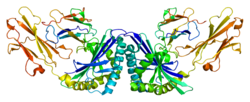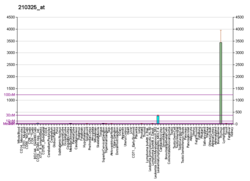CD1a (Cluster of Differentiation 1a) is a human protein encoded by the CD1A gene.[3]
This gene encodes a member of the CD1 family of transmembrane glycoproteins, which are structurally related to the major histocompatibility complex (MHC) proteins and form heterodimers with beta-2-microglobulin. The CD1 proteins mediate the presentation of primarily lipid and glycolipid antigens of self or microbial origin to T cells. The human genome contains five CD1 family genes organized in a cluster on chromosome 1. The CD1 family members are thought to differ in their cellular localization and specificity for particular lipid ligands. The protein encoded by this gene localizes to the plasma membrane and to recycling vesicles of the early endocytotic system. Alternatively spliced transcript variants have been observed, but their biological validity has not been determined.[3] Transcript levels of the CD1A gene are upregulated in the lung parenchyma of smokers.[4]
References
edit- ^ a b c GRCh38: Ensembl release 89: ENSG00000158477 – Ensembl, May 2017
- ^ "Human PubMed Reference:". National Center for Biotechnology Information, U.S. National Library of Medicine.
- ^ a b "Entrez Gene: CD1A CD1a molecule".
- ^ Pintarelli G, Noci S, Maspero D, Pettinicchio A, Dugo M, De Cecco L, Incarbone M, Tosi D, Santambrogio L, Dragani TA, Colombo F (September 2019). "Cigarette smoke alters the transcriptome of non-involved lung tissue in lung adenocarcinoma patients". Scientific Reports. 9 (1): 13039. Bibcode:2019NatSR...913039P. doi:10.1038/s41598-019-49648-2. PMC 6736939. PMID 31506599.
External links
editFurther reading
edit- Melián A, Beckman EM, Porcelli SA, Brenner MB (1996). "Antigen presentation by CD1 and MHC-encoded class I-like molecules". Curr. Opin. Immunol. 8 (1): 82–8. doi:10.1016/S0952-7915(96)80109-9. PMID 8729450.
- Park SH, Bendelac A (2000). "CD1-restricted T-cell responses and microbial infection". Nature. 406 (6797): 788–92. Bibcode:2000Natur.406..788P. doi:10.1038/35021233. PMID 10963609. S2CID 4373172.
- Brigl M, Brenner MB (2004). "CD1: antigen presentation and T cell function". Annu. Rev. Immunol. 22 (1): 817–90. doi:10.1146/annurev.immunol.22.012703.104608. PMID 15032598.
- Coventry B, Heinzel S (2004). "CD1a in human cancers: a new role for an old molecule". Trends Immunol. 25 (5): 242–8. doi:10.1016/j.it.2004.03.002. PMID 15099564.
- Moody DB, Zajonc DM, Wilson IA (2005). "Anatomy of CD1-lipid antigen complexes". Nat. Rev. Immunol. 5 (5): 387–99. doi:10.1038/nri1605. PMID 15864273. S2CID 1387491.
- Stove V, Verhasselt B (2006). "Modelling thymic HIV-1 Nef effects". Curr. HIV Res. 4 (1): 57–64. doi:10.2174/157016206775197583. PMID 16454711.
- Quaranta MG, Mattioli B, Giordani L, Viora M (2006). "The immunoregulatory effects of HIV-1 Nef on dendritic cells and the pathogenesis of AIDS". FASEB J. 20 (13): 2198–208. doi:10.1096/fj.06-6260rev. PMID 17077296. S2CID 3111709.
- Oakey RJ, Watson ML, Seldin MF (1993). "Construction of a physical map on mouse and human chromosome 1: comparison of 13 Mb of mouse and 11 Mb of human DNA". Hum. Mol. Genet. 1 (8): 613–20. doi:10.1093/hmg/1.8.613. PMID 1301170.
- Martin LH, Calabi F, Lefebvre FA, et al. (1988). "Structure and expression of the human thymocyte antigens CD1a, CD1b, and CD1c". Proc. Natl. Acad. Sci. U.S.A. 84 (24): 9189–93. doi:10.1073/pnas.84.24.9189. PMC 299718. PMID 2447586.
- Moseley WS, Watson ML, Kingsmore SF, Seldin MF (1989). "CD1 defines conserved linkage group border between human chromosomes 1 and mouse chromosomes 1 and 3". Immunogenetics. 30 (5): 378–82. doi:10.1007/BF02425278. PMID 2478463. S2CID 9361881.
- Yu CY, Milstein C (1990). "A physical map linking the five CD1 human thymocyte differentiation antigen genes". EMBO J. 8 (12): 3727–32. doi:10.1002/j.1460-2075.1989.tb08548.x. PMC 402056. PMID 2583117.
- Aruffo A, Seed B (1989). "Expression of cDNA clones encoding the thymocyte antigens CD1a, b, c demonstrates a hierarchy of exclusion in fibroblasts". J. Immunol. 143 (5): 1723–30. doi:10.4049/jimmunol.143.5.1723. PMID 2701945. S2CID 23168239.
- Longley J, Kraus J, Alonso M, Edelson R (1989). "Molecular cloning of CD1a (T6), a human epidermal dendritic cell marker related to class I MHC molecules". J. Invest. Dermatol. 92 (4): 628–31. doi:10.1111/1523-1747.ep12712175. PMID 2784820.
- Albertson DG, Fishpool R, Sherrington P, et al. (1988). "Sensitive and high resolution in situ hybridization to human chromosomes using biotin labelled probes: assignment of the human thymocyte CD1 antigen genes to chromosome 1". EMBO J. 7 (9): 2801–5. doi:10.1002/j.1460-2075.1988.tb03135.x. PMC 457071. PMID 3053166.
- Calabi F, Milstein C (1986). "A novel family of human major histocompatibility complex-related genes not mapping to chromosome 6". Nature. 323 (6088): 540–3. Bibcode:1986Natur.323..540C. doi:10.1038/323540a0. PMID 3093894. S2CID 4274219.
- Martin LH, Calabi F, Milstein C (1987). "Isolation of CD1 genes: a family of major histocompatibility complex-related differentiation antigens". Proc. Natl. Acad. Sci. U.S.A. 83 (23): 9154–8. doi:10.1073/pnas.83.23.9154. PMC 387093. PMID 3097645.
- Woolfson A, Milstein C (1994). "Alternative splicing generates secretory isoforms of human CD1". Proc. Natl. Acad. Sci. U.S.A. 91 (14): 6683–7. Bibcode:1994PNAS...91.6683W. doi:10.1073/pnas.91.14.6683. PMC 44267. PMID 7517559.
- Han M, Hannick LI, DiBrino M, Robinson MA (2000). "Polymorphism of human CD1 genes". Tissue Antigens. 54 (2): 122–7. doi:10.1034/j.1399-0039.1999.540202.x. PMID 10488738.
- Sugita M, Grant EP, van Donselaar E, et al. (2000). "Separate pathways for antigen presentation by CD1 molecules". Immunity. 11 (6): 743–52. doi:10.1016/S1074-7613(00)80148-X. PMID 10626896.
This article incorporates text from the United States National Library of Medicine, which is in the public domain.



